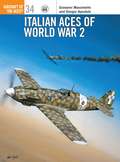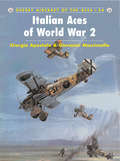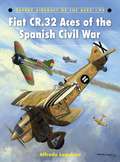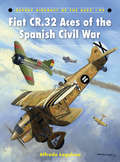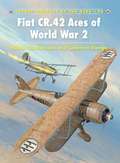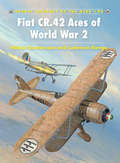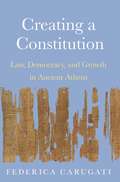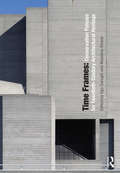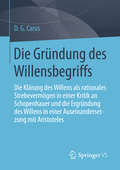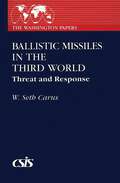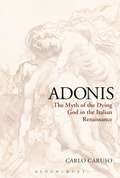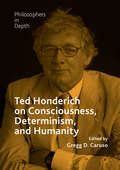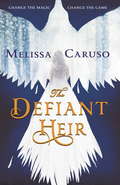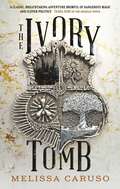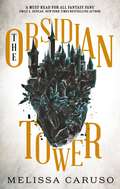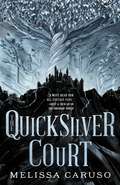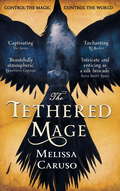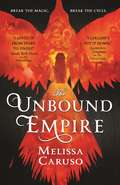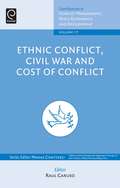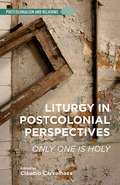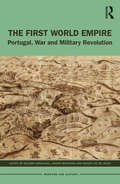- Table View
- List View
Italian Aces of World War 2 (Aircraft of the Aces)
by Richard Caruana Giorgio ApostoloFlying aircraft such as the Macchi 200-202, Fiat G.50 and biplane Fiat CR.42, the Italian fighter pilots were recognised by their Allied counterparts as brave opponents blessed with sound flying abilities, but employing under-gunned and underpowered equipment. Following the Italian surrender in September 1943, a number of aces continued to take the fight to the Allies as part of the Luftwaffe-run ANR, which was equipped with far more potent equipment such as the Bf 109G, Macchi 205V and Fiat G.55. Flying these types, the handful of ANR squadrons continued to oppose Allied bombing raids on northern Italy until VE-Day.
Italian Aces of World War 2 (Aircraft of the Aces #34)
by Richard Caruana Giorgio ApostoloFlying aircraft such as the Macchi 200-202, Fiat G.50 and biplane Fiat CR.42, the Italian fighter pilots were recognised by their Allied counterparts as brave opponents blessed with sound flying abilities, but employing under-gunned and underpowered equipment. Following the Italian surrender in September 1943, a number of aces continued to take the fight to the Allies as part of the Luftwaffe-run ANR, which was equipped with far more potent equipment such as the Bf 109G, Macchi 205V and Fiat G.55. Flying these types, the handful of ANR squadrons continued to oppose Allied bombing raids on northern Italy until VE-Day.
Fiat CR.32 Aces of the Spanish Civil War (Aircraft of the Aces)
by Richard Caruana Alfredo LogolusoThe CR.32 Falco was a handsome and highly manoeuvrable biplane fighter. During General Franco's fight with the Republicans for the control of Spain from 1936 – 39, no fewer than 477 CR.32s were involved, with an astounding 709 confirmed aerial victories, and an additional 320 kills claimed, for just 62 losses. As these statistics reveal, the CR.32 was the unrivalled master of the skies over Spain. By the war's end, the five leading aces of the conflict were all Spanish CR.32 pilots. Their exploits, and those of the other leading CR.32 aces, are examined for the first time in English in this exciting volume.
Fiat CR.32 Aces of the Spanish Civil War (Aircraft of the Aces #94)
by Richard Caruana Alfredo LogolusoThe CR.32 Falco was a handsome and highly manoeuvrable biplane fighter. During General Franco's fight with the Republicans for the control of Spain from 1936 – 39, no fewer than 477 CR.32s were involved, with an astounding 709 confirmed aerial victories, and an additional 320 kills claimed, for just 62 losses. As these statistics reveal, the CR.32 was the unrivalled master of the skies over Spain. By the war's end, the five leading aces of the conflict were all Spanish CR.32 pilots. Their exploits, and those of the other leading CR.32 aces, are examined for the first time in English in this exciting volume.
Fiat CR.42 Aces of World War 2 (Aircraft of the Aces)
by Richard Caruana Ludovico Slongo Håkan GustavssonThe Fiat CR.42, a logical development of the Fiat CR.32, was the last single-seat fighter biplane to be produced. It entered service with the Italian Regia Aeronautica in May 1939 before being exported to Belgium, Hungary and Sweden. Its combat debut came when the Belgian air force threw its fleet into action during the German invasion of the Low Countries on 10th May 1940. Despite being quickly overwhelmed, the Belgian pilots managed to make a number of aerial claims. The CR.42 became heavily involved in the fighting in North Africa and although it was gradually replaced by more modern fighters, it continued in a point defence and ground support role until the end of the war. Drawing on research from a range of sources, this book examines the extensive employment of the Italian fighter plane during the course of World War II.
Fiat CR.42 Aces of World War 2 (Aircraft of the Aces)
by Richard Caruana Ludovico Slongo Håkan GustavssonThe Fiat CR.42, a logical development of the Fiat CR.32, was the last single-seat fighter biplane to be produced. It entered service with the Italian Regia Aeronautica in May 1939 before being exported to Belgium, Hungary and Sweden. Its combat debut came when the Belgian air force threw its fleet into action during the German invasion of the Low Countries on 10th May 1940. Despite being quickly overwhelmed, the Belgian pilots managed to make a number of aerial claims. The CR.42 became heavily involved in the fighting in North Africa and although it was gradually replaced by more modern fighters, it continued in a point defence and ground support role until the end of the war. Drawing on research from a range of sources, this book examines the extensive employment of the Italian fighter plane during the course of World War II.
Creating a Constitution: Law, Democracy, and Growth in Ancient Athens
by Federica CarugatiA comprehensive account of how the Athenian constitution was created—with lessons for contemporary constitution-buildingWe live in an era of constitution-making. More than half of the world's constitutions have been drafted in the past half-century. Yet, one question still eludes theorists and practitioners alike: how do stable, growth-enhancing constitutional structures emerge and endure? In Creating a Constitution, Federica Carugati argues that ancient Athens offers a unique laboratory for exploring this question. Because the city-state was reasonably well-documented, smaller than most modern nations, and simpler in its institutional makeup, the case of Athens reveals key factors of successful constitution-making that are hard to flesh out in more complex settings.Carugati demonstrates that the institutional changes Athens undertook in the late fifth century BCE, after a period of war and internal strife, amounted to a de facto constitution. The constitution restored stability and allowed the democracy to flourish anew. The analysis of Athens's case reveals the importance of three factors for creating a successful constitution: first, a consensus on a set of shared values capable of commanding long-term support; second, a self-enforcing institutional structure that reflects those values; and, third, regulatory mechanisms for policymaking that enable tradeoffs of inclusion to foster growth without jeopardizing stability.Uniquely combining institutional analysis, political economy, and history, Creating a Constitution is a compelling account of how political and economic goals that we normally associate with Western developed countries were once achieved through different institutional arrangements.
Creating a Constitution: Law, Democracy, and Growth in Ancient Athens
by Federica CarugatiA comprehensive account of how the Athenian constitution was created—with lessons for contemporary constitution-buildingWe live in an era of constitution-making. More than half of the world's constitutions have been drafted in the past half-century. Yet, one question still eludes theorists and practitioners alike: how do stable, growth-enhancing constitutional structures emerge and endure? In Creating a Constitution, Federica Carugati argues that ancient Athens offers a unique laboratory for exploring this question. Because the city-state was reasonably well-documented, smaller than most modern nations, and simpler in its institutional makeup, the case of Athens reveals key factors of successful constitution-making that are hard to flesh out in more complex settings.Carugati demonstrates that the institutional changes Athens undertook in the late fifth century BCE, after a period of war and internal strife, amounted to a de facto constitution. The constitution restored stability and allowed the democracy to flourish anew. The analysis of Athens's case reveals the importance of three factors for creating a successful constitution: first, a consensus on a set of shared values capable of commanding long-term support; second, a self-enforcing institutional structure that reflects those values; and, third, regulatory mechanisms for policymaking that enable tradeoffs of inclusion to foster growth without jeopardizing stability.Uniquely combining institutional analysis, political economy, and history, Creating a Constitution is a compelling account of how political and economic goals that we normally associate with Western developed countries were once achieved through different institutional arrangements.
Time Frames: Conservation Policies for Twentieth-Century Architectural Heritage
by Ugo Carughi Massimo VisoneTime Frames provides a reconnaissance on the conservation rules and current protection policies of more than 100 countries, with particular attention to the emerging nations and twentieth-century architecture. The contributions illustrate the critical issues related to architectural listings, with a brief history of national approaches, a linkography and a short bibliography. The book also provides a short critical lexicography, with 12 papers written by scholars and experts including topics on identities, heritages, conservation, memories and the economy. By examining the methods used to designate building as heritage sites across the continents, this book provides a comprehensive overview of current protection policies of twentieth-century architecture as well as the role of architectural history.
Time Frames: Conservation Policies for Twentieth-Century Architectural Heritage
by Ugo Carughi Massimo VisoneTime Frames provides a reconnaissance on the conservation rules and current protection policies of more than 100 countries, with particular attention to the emerging nations and twentieth-century architecture. The contributions illustrate the critical issues related to architectural listings, with a brief history of national approaches, a linkography and a short bibliography. The book also provides a short critical lexicography, with 12 papers written by scholars and experts including topics on identities, heritages, conservation, memories and the economy. By examining the methods used to designate building as heritage sites across the continents, this book provides a comprehensive overview of current protection policies of twentieth-century architecture as well as the role of architectural history.
Die Gründung des Willensbegriffs: Die Klärung des Willens als rationales Strebevermögen in einer Kritik an Schopenhauer und die Ergründung des Willens in einer Auseinandersetzung mit Aristoteles
by D. G. CarusMit diesem Werk wird zum ersten Mal der Willensbegriff gegründet, indem der intellektuelle Wille im Unterschied und in Erweiterung von einem rein vorstellenden rationalen Willen deutlich erfasst wird. Es wird im Verhältnis zu den anderen Strebevermögen gezeigt, dass der intellektuelle Wille das Strebevermögen des Menschen vervollkommnet und somit das Gute der Praxis im erkennenden Subjekt liegt. Im ersten Teil wird der Wille als Strebevermögen bei Arthur Schopenhauer analysiert, um in einer Kritik aufzuweisen, dass der Wille ein rationales Strebevermögen ist. Im nächsten Schritt wird der rationale und gute Wille bei Aristoteles in seiner Bedingtheit durch die intellektuelle Tugend der Klugheit aufgezeigt und nachgewiesen, dass der intellektuelle Wille in Abgrenzung von einem vorstellenden rationalen Willen von Aristoteles nicht hinreichend erfasst worden ist. Abschließend wird erklärt, dass die sittliche Tugend kein Prinzip der Moralität sein kann und allein der intellektuelle Wille das Prinzip des Guten abgibt.
Ballistic Missiles in the Third World: Threat and Response (The Washington Papers)
by W. Seth CarusThe proliferation of ballistic missiles in the Third World has posed a new type of challenge to policy makers in the United States. More than twenty Third World countries either possess surface-to-surface missiles or are trying to develop or acquire them. Current trends suggest that the number of countries with missiles will increase in the 1990s and that the capabilities of the available systems will also grow. W. Seth Carus assesses the threat of such proliferation to United States military forces as well as those of its allies operating in the Third World. The book studies the military utility of these missiles to the countries that possess them and covers the various military responses of Third World countries to missile proliferation.Carus also examines the various attempts the United States has made to slow the proliferation of ballistic missiles. Washington has joined many of its allies in the Missile Technology Control Regime (MTCR), a suppliers agreement designed to restrict exports of missiles and missile technologies to the Third World. According to Carus, efforts have been made to persuade the Soviet Union, China and other countries to abide by the provisions of the MTCR. After discussing the bilateral talks with proliferating countries, Carus also analyzes the attempts made to derail specific missile programs and the difficulties involved in controlling missile technology.
Adonis: The Myth of the Dying God in the Italian Renaissance
by Carlo CarusoIn this detailed treatment of the myth of Adonis in post-Classical times, Carlo Caruso provides an overview of the main texts, both literary and scholarly, in Latin and in the vernacular, which secured for the Adonis myth a unique place in the Early Modern revival of Classical mythology. While aiming to provide this general outline of the myth's fortunes in the Early Modern age, the book also addresses three points of primary interest, on which most of the original research included in the work has been conducted. First, the myth's earliest significant revival in the age of Italian Humanism, and particularly in the poetry of the great Latin poet and humanist Giovanni Pontano. Secondly, the diffusion of syncretistic interpretations of the Adonis myth by means of authoritative sixteenth-century mythological encyclopaedias. Thirdly, the allegorical/political use of the Adonis myth in G.B. Marino's (1569-1625) Adone, published in Paris in 1623 to celebrate the Bourbon dynasty and to support their legitimacy with regard to the throne of France.
Adonis: The Myth of the Dying God in the Italian Renaissance
by Carlo CarusoIn this detailed treatment of the myth of Adonis in post-Classical times, Carlo Caruso provides an overview of the main texts, both literary and scholarly, in Latin and in the vernacular, which secured for the Adonis myth a unique place in the Early Modern revival of Classical mythology. While aiming to provide this general outline of the myth's fortunes in the Early Modern age, the book also addresses three points of primary interest, on which most of the original research included in the work has been conducted. First, the myth's earliest significant revival in the age of Italian Humanism, and particularly in the poetry of the great Latin poet and humanist Giovanni Pontano. Secondly, the diffusion of syncretistic interpretations of the Adonis myth by means of authoritative sixteenth-century mythological encyclopaedias. Thirdly, the allegorical/political use of the Adonis myth in G.B. Marino's (1569-1625) Adone, published in Paris in 1623 to celebrate the Bourbon dynasty and to support their legitimacy with regard to the throne of France.
Ted Honderich on Consciousness, Determinism, and Humanity
by Gregg D. CarusoThis collection of original essays brings together a world-class lineup of philosophers to provide the most comprehensive critical treatment of Ted Honderich’s philosophy, focusing on three major areas of his work: (1) his theory of consciousness; (2) his extensive and ground-breaking work on determinism and freedom; and (3) his views on right and wrong, including his Principle of Humanity and his judgments on terrorism. Grote Professor Emeritus of the Philosophy of Mind and Logic at University College London, Honderich is a leading contemporary philosopher of mind, determinism and freedom, and morals. The collection begins with a comprehensive introduction written by Honderich followed by fourteen original chapters separated into three sections. Each section concludes with a set of remarks by Honderich. Contributors include Noam Chomsky, Paul Snowdon, Alastair Hannay, Barbara Gail Montero, Barry Smith, Derk Pereboom, Paul Russell, Kevin Timpe, Gregg D. Caruso, Mary Warnock, Paul Gilbert, Richard J. Norman, Michael Neumann, and Saul Smilansky.
Ted Honderich on Consciousness, Determinism, and Humanity
by Gregg D. CarusoThis collection of original essays brings together a world-class lineup of philosophers to provide the most comprehensive critical treatment of Ted Honderich’s philosophy, focusing on three major areas of his work: (1) his theory of consciousness; (2) his extensive and ground-breaking work on determinism and freedom; and (3) his views on right and wrong, including his Principle of Humanity and his judgments on terrorism. Grote Professor Emeritus of the Philosophy of Mind and Logic at University College London, Honderich is a leading contemporary philosopher of mind, determinism and freedom, and morals. The collection begins with a comprehensive introduction written by Honderich followed by fourteen original chapters separated into three sections. Each section concludes with a set of remarks by Honderich. Contributors include Noam Chomsky, Paul Snowdon, Alastair Hannay, Barbara Gail Montero, Barry Smith, Derk Pereboom, Paul Russell, Kevin Timpe, Gregg D. Caruso, Mary Warnock, Paul Gilbert, Richard J. Norman, Michael Neumann, and Saul Smilansky.
The Defiant Heir (Swords and Fire #2)
by Melissa Caruso'Melissa Caruso has taken things to an ENTIRELY new level of awesome' Powder and Page'Caruso has really hit her fantasy stride with The Defiant Heir' CultureflyAcross the border, the Witch Lords are preparing for war. But before an invasion of Raverra can begin, all seventeen Witch Lords must gather to agree a course of action. Lady Amalia Cornaro knows that this conclave might be her only chance to stifle the growing flames of war. Amalia and her warlock Zaira must go behind enemy lines, using every ounce of wit and cunning they have to avert the coming conflict. If they fail, it will all come down to swords and fire.The Defiant Heir continues the spellbinding tale of courtly intrigue and dangerous magic that began with Gemmell Award shortlisted debut The Tethered Mage.Praise for the series:The Tethered Mage is an excellent debut novel that set a high bar for its follow up, but The Defiant Heir takes the series to the next level in every way . . . I can hardly contain my excitement for the third installment'Fantasy Book Cafe'I couldn't put it down' Genevieve Cogman, author of The Invisible Library I raced through this exquisite debut in three days and adored it' - Fantasy Book Review'Absolutely recommended and on my shortlist for favorite books so far in 2017' - Book Smugglers'A brilliant novel' - The Eloquent Page'Fantastically readable, incredibly addictive and intelligently plotted . . . I loved it' - Liz Loves Books'Captivating' - Vic James, author of Gilded Cage'If you like fantasy, you'll love this book' - The Tattooed Book Geek
The Ivory Tomb: Rooks and Ruin, Book Three (Rooks and Ruin #3)
by Melissa Caruso'Truly excellent fantasy' Locus on The Obsidian Tower The Ivory Tomb concludes the wildly original epic fantasy series bursting with intrigue and ambition, questioned loyalties, and broken magic that began with The Obsidian Tower.The Dark Days have returned. The Demon of Carnage mercilessly cuts through villagers and armies. The Demon of Corruption rots the land. The Serene Empire and the Witch Lords race towards war. And in the middle of it all stands Rxyander, the Warden of Gloamingard. Burdened by conflicting loyalties and guilt, Ryx searches desperately for a way to defeat the demons before the world she loves is completely destroyed. To find answers, she'll have to return to where it all started. . . the black tower at the heart of Gloamingard. By blood the Door was opened and only by blood will the Dark Days end. Praise for the series:'With this novel, Melissa Caruso solidifies herself as one of my favourite authors. The Obsidian Tower is a masterpiece of character-driven fantasy . . . I was enthralled from the first page' Fantasy Book Review'Block out time to binge this can't-stop story filled with danger and unexpected disaster . . . The Obsidian Tower is a must-read for lovers of high fantasy' C. L. Polk, World Fantasy Award-winning author'A classic, breathtaking adventure brim-full of dangerous magic and clever politics. This is a book that will thrill and delight any fantasy fan' Tasha Suri, author of The Jasmine Throne'Brimming with delights: gripping suspense, bombastic magic, political scheming, fascinating creatures, and ill-advised romance.' Jon Skovron, on The Obsidian Tower
The Obsidian Tower (The Gate of Secrets)
by Melissa CarusoOne woman will either save an entire continent or completely destroy it in a captivating epic fantasy bursting with intrigue and ambition, questioned loyalties, and broken magic.'Guard the tower, ward the stone. Find your answers writ in bone. Keep your trust through wits or war--nothing must unseal the door.'Deep within Gloamingard Castle lies a black tower. Sealed by magic, it guards a dangerous secret that has been contained for thousands of years.As Warden, Ryxander knows the warning passed down through generations: nothing must unreal the Door. But one impetuous decision will leave her with blood on her hands--and unleash a threat that could doom the world to fall to darkness.Praise for Melissa Caruso:'A must-read for lovers of high fantasy' C. L. Polk, author of World Fantasy Award-winner Witchmark 'I think [Caruso] is sublimely talented . . . A phenomenally well-written, engrossing political fantasy series' Fantasy Book Review'Caruso's world-building is brilliant and complex' Library Journal'A dashing, compelling and exciting story, blending magic, assassination, conspiracy and diplomacy . . . I'll make no bones about it, I loved this book' Blue Book Balloon on The Defiant Heir
The Quicksilver Court (Rooks and Ruin #2)
by Melissa CarusoThe Quicksilver Court continues the wildly original epic fantasy series bursting with intrigue and ambition, questioned loyalties, and broken magic that began with The Obsidian Tower.Ryxander has failed. Unsealed by her blood, the Door hidden within the black tower of Gloamingard has opened. Now, for the first time since the age of the Graces, demons walk the world.As tensions grow between nations, all eyes-and daggers-are set on Morgrain, which has fallen under the Demon of Discord's control. When an artefact with the power to wipe out all life in a domain is stolen, Ryx will do whatever it takes to save her home from destruction. But success may demand a larger sacrifice from Ryx than she could have imagined.Praise for Melissa Caruso'Caruso is a terrific writer who weaves fascinating and intricate fantasy tales' Grimdark Magazine'With this novel, Melissa Caruso solidifies herself as one of my favourite authors. The Obsidian Tower is a masterpiece of character-driven fantasy . . . I was enthralled from the first page' Fantasy Book Review'This is a truly excellent fantasy and an epic beginning for a new trilogy. I can't wait to see what [Caruso] does next' Locus
The Tethered Mage (Swords and Fire #1)
by Melissa Caruso***SHORTLISTED FOR THE 2018 GEMMELL AWARD FOR BEST DEBUT***'I couldn't put it down' Genevieve Cogman, author of The Invisible Library'I raced through this exquisite debut in three days and adored it' Fantasy Book ReviewIn the Raverran Empire, magic is scarce and those born with power are strictly controlled - taken as children and conscripted into the Falcon Army. Zaira has lived her life on the streets to avoid this fate, hiding her mage-mark and thieving to survive. But hers is a rare and dangerous magic, one that could threaten the entire empire.Lady Amalia Cornaro was never meant to be a Falconer. Heiress and scholar, she was born into a treacherous world of political machinations. But fate has bound the heir and the mage. And as war looms on the horizon, a single spark could turn their city into a pyre.SET IN A RICH WORLD OF POLITICAL INTRIGUE AND DANGEROUS MAGIC, THE TETHERED MAGE IS A SPELLBINDING DEBUT FROM A MAJOR NEW TALENT.'Absolutely recommended and on my shortlist for favorite books so far in 2017'Book Smugglers'A brilliant novel' The Eloquent Page'Fantastically readable, incredibly addictive and intelligently plotted . . . I loved it' Liz Loves Books'If you like fantasy, you'll love this book' The Tattooed Book Geek
The Unbound Empire (Swords and Fire #3)
by Melissa Caruso'This is a series worth your time' The Quill to Live'A dashing, compelling and exciting story, blending magic, assassination, conspiracy and diplomacy . . . I loved this book' Blue Book Balloon on The Defiant HeirWhile winter snows keep the invading armies of the Witch Lord Ruven at bay, Lady Amalia Cornaro and the fire warlock Zaira attempt to change the fate of mages in the Serene Empire forever. But on the night of Raverra's great masquerade, Ruven executes a devastating surprise strike at the heart of the Empire - threatening everything Amalia holds most dear.To stand a chance of defeating Ruven, Amalia and Zaira must face their worst nightmares, expose their deepest secrets and unleash Zaira's ravaging fire.The Unbound Empire is the epic finale to the spellbinding tale of courtly intrigue and dangerous magic that began with The Tethered Mage and The Defiant Heir.Praise for the series:'I couldn't put it down' Genevieve Cogman, author of The Invisible Library'I wouldn't hesitate to recommend this series' Girls in Capes'I raced through this exquisite debut in three days and adored it' Fantasy Book Review'Wonderful characters and intriguing mysteries that kept me eagerly anticipating what would happen next . . . I can hardly contain my excitement for the third instalment' Fantasy Book Cafe'Absolutely recommended' Book Smugglers
Ethnic Conflicts, Civil War and Cost of Conflict (Contributions to Conflict Management, Peace Economics and Development #17)
by Raul Caruso Manas ChatterjiThis volume of "Contributions to Conflict Management, Peace Economics and Development" includes some of the selected papers presented by scholars in a European Peace Science Network Meeting recently held in Amsterdam, The Netherlands. Chapters in this volume cover the conflicts in Maoist India, South America, and Sub-Saharan Africa. The authors have employed highly sophisticated quantitative techniques and principles of Economics and Political Science in determining the causes of these ethnic conflicts and effects on human and material resources.
Liturgy in Postcolonial Perspectives: Only One Is Holy (Postcolonialism and Religions)
by Cláudio CarvalhaesThis book brings Christian, Jewish and Muslim scholars from different fields of knowledge and many places across the globe to introduce/expand the dialogue between the field of liturgy and postcolonial/decolonial thinking. Connecting main themes in both fields, this book shows what is at stake in this dialectical scholarship.
The First World Empire: Portugal, War and Military Revolution (Warfare and History)
by Hélder Carvalhal André Murteira Roger Lee De JesusThis book offers a comprehensive overview of the early modern military history of Portugal and its possessions in Africa, America, and Asia from the perspective of the Military Revolution historiographical debate. The existence of a military revolution in the early modern period has been much debated within international historiography and this volume fills a significant gap in its relation to the history of Portugal and its overseas empire. It examines different forms of military change in specifically Portuguese case studies, but also adopts a global perspective through the analysis of different contexts and episodes in Africa, America, and Asia. Contributors explore whether there is evidence of what could be defined as aspects of a military revolution, or, alternatively, whether other explanatory models are needed to account for different forms of military change. As such, it offers the reader a variety of perspectives that contribute to the debate over the applicability of the Military Revolution concept to Portugal and its empire during the early modern period. Broken down into four thematic parts and broad in both chronological and geographical scope, the book deepens our understanding of the art of warfare in Portugal and its empire and demonstrates how the Military Revolution debate can be used to examine military change in a global perspective. This is an essential text for scholars and students of military history, military architecture, global history, Asian history and the history of Iberian empires.
